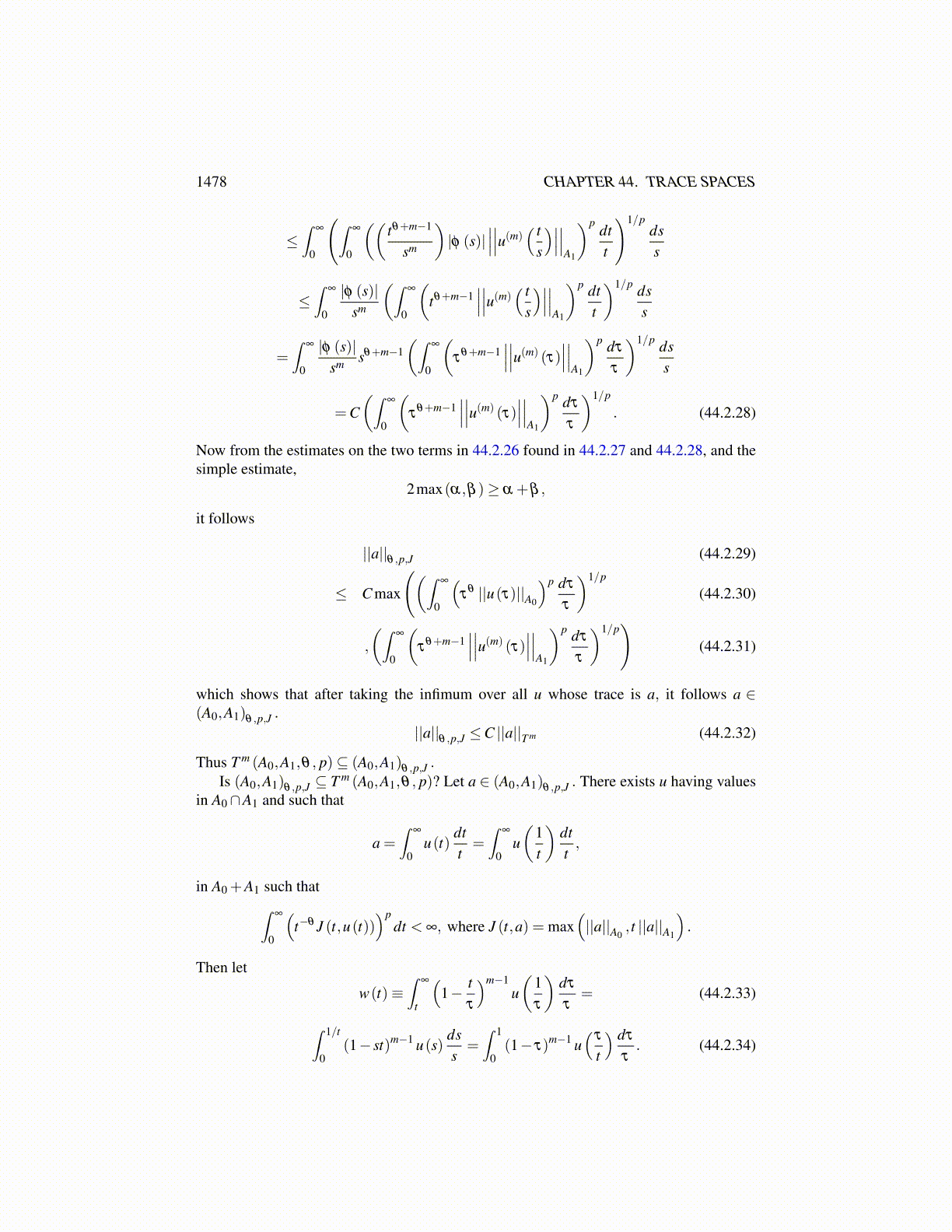
1478 CHAPTER 44. TRACE SPACES
and so ∣∣∣∣∣∣ũ(k) (t)∣∣∣∣∣∣A0≤Ck
∫ t/α
t/β
||u(τ)||A0
dτ
τ
≤C(∫ t/α
t/β
dτ
τ
)1/p′(∫ t/α
t/β
||u(τ)||pA0
dτ
τ
)1/p
.
Now(
β
t
)θ
τθ ≥ 1 for τ ≥ t/β and so the above expression
≤C(
lnβ
α
)1/p′(β
t
)θ (∫ ∞
t/β
(τ
θ ||u(τ)||A0
)p dτ
τ
)1/p
and so limt→∞
∣∣∣∣∣∣ũ(k) (t)∣∣∣∣∣∣A0
= 0 and therefore, this also holds in A0 +A1. This proves the
claim.Thus ũ has the same properties as u in terms of having a as its trace. ũ is used to build
the desired w, representing a as an integral. Define
v(t)≡ (−1)m tm
(m−1)!ũ(m) (t) =
(−1)m
(m−1)!
∫∞
0
tm
τm φ(m)( t
τ
)u(τ)
dτ
τ
=(−1)m
(m−1)!
∫∞
0sm
φ(m) (s)u
( ts
) dss. (44.2.23)
Then from the claim, and integration by parts in the last step,∫∞
0v(
1t
)dtt=∫
∞
0v(t)
dtt=
(−1)m
(m−1)!
∫∞
0tm−1ũ(m) (t)dt = a. (44.2.24)
Thus v( 1
t
)represents a in the way desired for (A0,A1)θ ,p,J if it is also true that v
( 1t
)∈
A0 ∩A1 and t → t−θ v( 1
t
)is in Lp
(0,∞, dt
t ;A0)
and t → t1−θ v( 1
t
)is in Lp
(0,∞, dt
t ;A1).
First consider whether v(t)∈ A0∩A1. v(t)∈ A0 for each t from 44.2.23 and the assumptionthat u ∈ Lp
(0,∞, dt
t ;A0). To verify v(t) ∈ A1, integrate by parts in 44.2.23 to obtain
v(t) =(−1)m
(m−1)!
∫∞
0φ(m) (s)
(sm−1u
( ts
))ds (44.2.25)
=1
(m−1)!
∫∞
0φ (s)
dm
dsm
(sm−1u
( ts
))ds
=(−1)m
(m−1)!
∫∞
0φ (s)
tm
sm+1 u(m)( t
s
)ds ∈ A1
The last step may look very mysterious. If so, consider the case where m = 2.
φ (s)(
su( t
s
))′′= φ (s)
(− t
su′( t
s
)+u( t
s
))′= φ (s)
((− t
s
)u′′( t
s
)(− t
s2
)+
ts2 u′
( ts
)− t
s2 u′( t
s
))= φ (s)
t2
s3 u′′( t
s
).